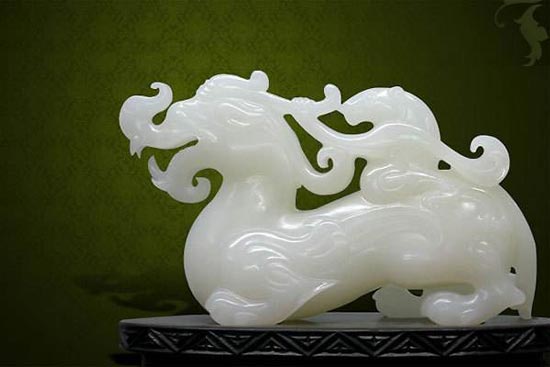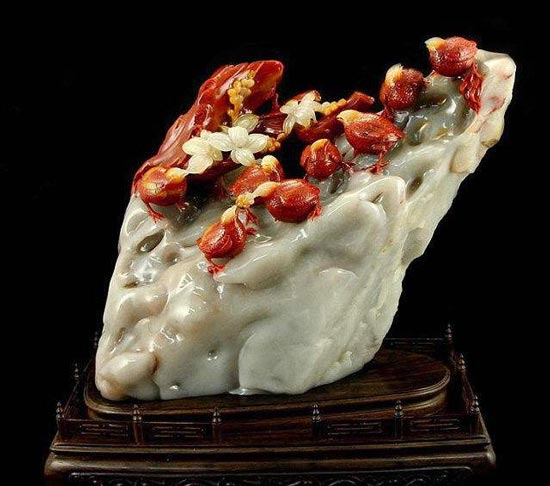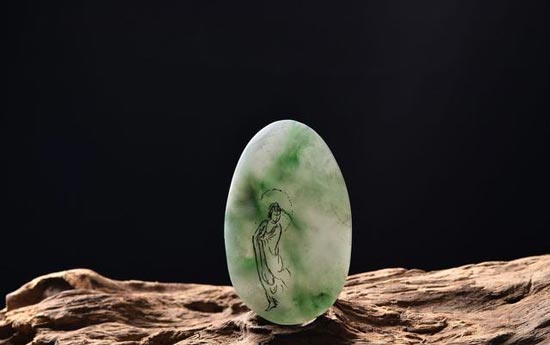Jade carving products can be said to be the jade products that best reflect the beauty of jade, and the essence of jade culture. The jade carving process makes the jade material a unique and self-contained family that is different from other natural gem resources. The quality of the carvings greatly affects the value of the finished product.
The content of jade carving products is very wide. It usually refers to jade products with jacquard surfaces and even patterns and patterns inside. The most important ones are jade carving ornaments, such as figures, flowers, birds, beasts, flowers, furnishings, and large jade carvings. In addition, they also include various flower pieces, such as various listings, pendants, or accessories. Antique jade pieces and practical utensils such as stationery, tea sets, smoking sets, wine sets, etc.; also include jewelry that needs to be processed with jade carving and so on. The processing of jade carving products is different from the previous type, and is relatively complicated, and usually requires special equipment to complete. The processing technology of jade carving products is usually divided into five processes of material selection, design, honing, polishing and waxing. The design and carving process are the most complicated.

1. Design and material selection
For jade carving crafts, the relationship between material selection and design is difficult to say who is the first and then, sometimes there may be jade, and then design jade carving plan; sometimes it may be the first jade carving plan to choose jade. Usually it is based on the material, that is, the first jade material, the latter design. The material selection should pay attention to the quality and size of the jade material, and there should be no large cracks and flaws. If it is to be specifically designed and selected, it is necessary to choose the texture, color and characteristics in order to be in harmony with the theme of the design.
A perfect jade carving handicraft should be highly harmonious and beautiful in shape and beauty. It depends on the design of the original stone. Therefore, design is especially important. Usually the designers of jade carving crafts not only know the art design, but also understand the various characteristics of various jade such as toughness or brittleness, hardness, heat sensitivity, chemical stability, crack development, enthalpy extension, etc., which can really guarantee the design. The final implementation, otherwise it is likely to die halfway. Design work is not only done before the beginning of the honing, but often throughout the production process. The designer should change the design draft at any time according to the changes in the jade material production and the ability and level of the producer, and gradually guide the completion of the production.
Jade carving design is generally divided into two processes: rough drawing and fine drawing. The rough drawing is to draw the shape and pattern directly on the jade before starting to ponder; the fine drawing is to draw some detailed requirements in the production, so that the producer can understand the design intent. After the design draft is drawn on the jade, processing can begin.

2, honing
Honing is a large process that is designed according to the design requirements. It is usually divided into two sub-steps: cutting and carving.
The cutting process is relatively simple, that is, the cutting tool is used to remove the stone skin (if any) and the corners other than the design contour. In addition, you should also dig out the dirty or dirty spots that can not be used, and remove the "sand" or miscellaneous stones that hinder the design. Finally, a jade carving blank with a prototype is obtained. Some of the basic techniques in this process in the jade carving industry have special names, such as enamel, enamel, buckle, etc.铡 切削 cutting, cutting out the unwanted parts; 摽 is to remove the edges; buckle is to dig dirty spots or "sand", miscellaneous stones and so on. In fact, this technique is also used in the carving process. The tools used for cutting are mainly blunt, boring, wire saws, cutting saws, buckles, etc. for cutting.
Engraving is the process of designing the shape, the basic methods and steps are punching, grinding, blunt hooks and so on.
The so-called rush refers to the grinding of a large area. Use a blunt (3~4cm diameter) or diamond wheel to punch the uneven part into a jade blank.
The so-called grinding is to grind a large sample with different sizes of grinding, that is, to sharpen the contour shape of the main part of the design, such as the head, hands and body of the character.
The so-called rolling refers to the deep grinding, that is, the three-dimensional feeling of the blunt rolling of the thinner part, such as opening the face of the person's head, rolling out the mouth, nose, ears and the like.
The stomach hook, that is, use the hook to drag out the fine patterns of the details, such as the character's hair and the bird feather dragon scales. The details of the carvings are also the methods of withdrawing, smashing and smashing. Therefore, the carving tools used should also have different functions. In addition to rushing, honing, rolling, hooking, there are also hammers, nails and rods. Very, flat, and so on. These tools are the names of traditional jade carving tools. They used to be made of iron. When used, they drive the emery to polish the jade. Nowadays, the use of tools for fixing diamond powder is much more efficient.
Jade carving, usually using specialized jade carving equipment. The jade carving equipment is mainly composed of a motor working head, a belt transmission device, a grinding head, a water tank and a tool box. The motor and the working head are connected by steel columns and can be lifted at the same time. The belt drive drives the grinding head at the left end of the working head under the drive of the motor. Different honing purposes are achieved by switching to different grinding heads. Grinding heads are abrasive tools of various shapes. At present, most of them are electroplated drill bits, because of their high grinding efficiency, long service life and low price.

3, polishing
The jade that is designed and shaped is also polished. The specific operation of polishing is similar to honing, but the tools and abrasives (ie, polishing agents) used are different from honing. The tool is generally made of resin, glue, wood, cloth, leather, gourd leather, etc., and is similar to a tool made of a honing iron tool or a diamond grinding head to drive the polishing powder for polishing. It can also be polished by a dip machine. It takes a long time to polish the dip, which takes about a week, but it can polish many pieces at a time.
4, wax and dressing
The jade carving products after polishing are usually required to be waxed. The waxing method is similar to that described above. When it is only proposed from the wax liquid, it is necessary to carefully wipe the excess wax liquid, especially the concave seam of the jade carving, so that the jade carving crafts shine.
For jade carving crafts, the wax is not the end, but also need to be equipped with the appropriate wooden seat and brocade box, that is, complete the jade costume, it is really finished.
WE CAN PRODUCE 4D*51MM ,6D*51MM ,15D*51MM ,BOTH WHITE AND BLACK .
Low Melting Fiber,Low Melting Point Fibers,Low Melting Point Polyester Fiber,Low-Melting Bicomponent Fiber
JIANGYIN ZHONGXIE NEW MATERIAL CO.,LTD , https://www.zhongxiegroup.com